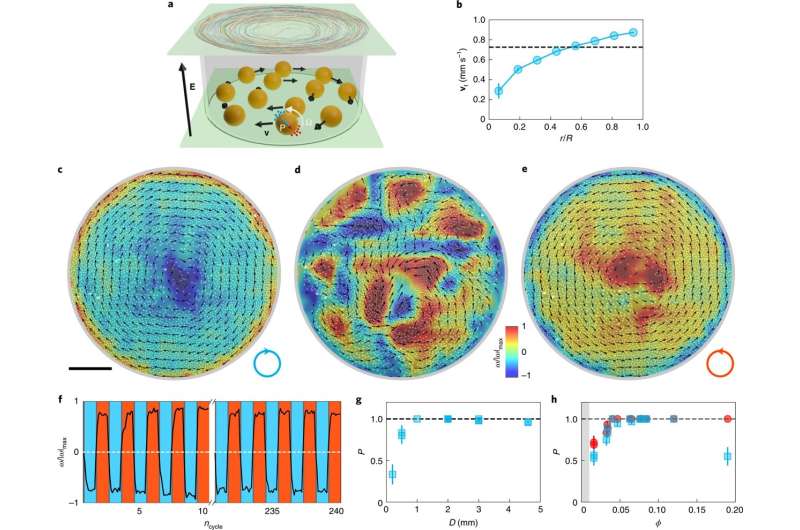Microparticles show ability to turn in reverse, paving the way for microfluidic devices

Like middle school students, microparticles are not the world's most graceful dancers. For many of them, it's one step forward, one step back.
In a new study from the U.S. Department of Energy's (DOE) Argonne National Laboratory, researchers have identified how a self-organized vortex of rotating microparticles in a fluid will reverse direction when an electric stimulus is interrupted and then reapplied with the same orientation, providing fundamental insights into mechanisms behind the sudden switch in rotation. The research offers potential inspiration for pumps in microsized channels, called microfluidic pumps, that allow the controlled flow of liquids. Such pumps allow precise fluid delivery for biomedical, chemical and electronics applications.
These vortices of microparticles, which are engineered particles less than a millimeter in diameter, show evidence of what scientists call "emergent behavior"—a kind of self-organization and collective motion. In their native state, the particles are distributed randomly, but when scientists apply an electric field, they begin to synchronize their motion and rotate together either clockwise or counterclockwise.
"The particles are like dancers when we turn on the electric music," said Argonne materials scientist Alexey Snezhko, who led the study. "When conditions are right, they all start moving with a particular motion tied together."
Argonne scientists wanted to investigate how these collective self-assembled states can be controlled and manipulated. In particular, they wanted to see what would happen when they stopped and then restarted the field fueling the motion of the particles. To their surprise, the particles' relative positions created a kind of distributed collective memory that caused them to begin to rotate in the opposite direction.
"It's not like these particles have brains," Snezhko said. "But what's really interesting is that the collective nature of the vortices enables the entire system to reverse direction."
The reversal of the particles' rotation is caused by a combination of two kinds of forces. The first force is called an electrostatic force, which basically causes neighboring rolling particles to repel one another. This force works only over short distances—particles need to be more or less touching each other in order to experience it.
The second force is called a hydrodynamic force—it relates to the relationship between the rolling particles and the fluid in the medium they sit in. The rolling particles create flows that push and realign particles, and the corresponding force works at longer range.
"The collective behavior we see in these particles is similar to that of migrating birds," Snezhko said. "Obviously, birds don't want to bump into each other—that's similar to our electrostatic interaction. However, they also need to match the velocity of birds somewhat farther away—that's like hydrodynamics."
With only the electrostatic forces or the hydrodynamic forces, the reversal would not happen, Snezhko said. "It is a fine interplay between the two forces that drives this phenomenon," he said.
Snezhko explained that the hydrodynamic forces create local asymmetries in the particles' relative positions within a vortex, which pave the way for the reversal that is ultimately triggered by the electrostatic interactions.
Although Snezhko explained that the memory of the particle vortices could not work as a computer memory, he said that the reversal of the system could be useful for materials that work on a toggle system, like microfluidic pumps or other kinds of biomechanical switches, for instance for drug delivery.
"Active materials like these self-assembled particle vortices have a wide range of potential applications," Snezhko said. "Characterizing the behavior of these systems under a range of conditions is essential for being able to control and make the most of their properties."
A paper based on the study, "Polar state reversal in active fluids," appeared online in Nature Physics on Dec. 23, 2021.
More information: Bo Zhang et al, Polar state reversal in active fluids, Nature Physics (2021). DOI: 10.1038/s41567-021-01442-6
Journal information: Nature Physics
Provided by Argonne National Laboratory





















